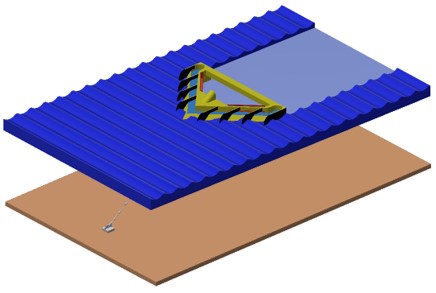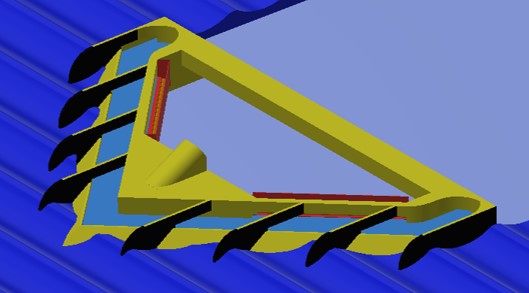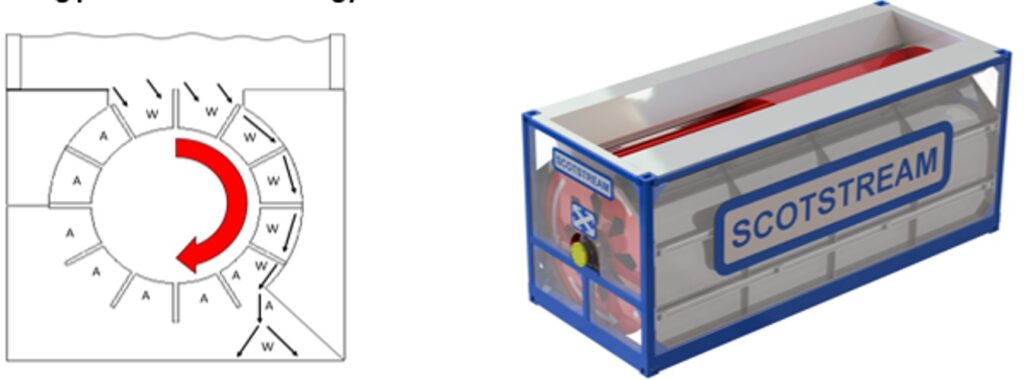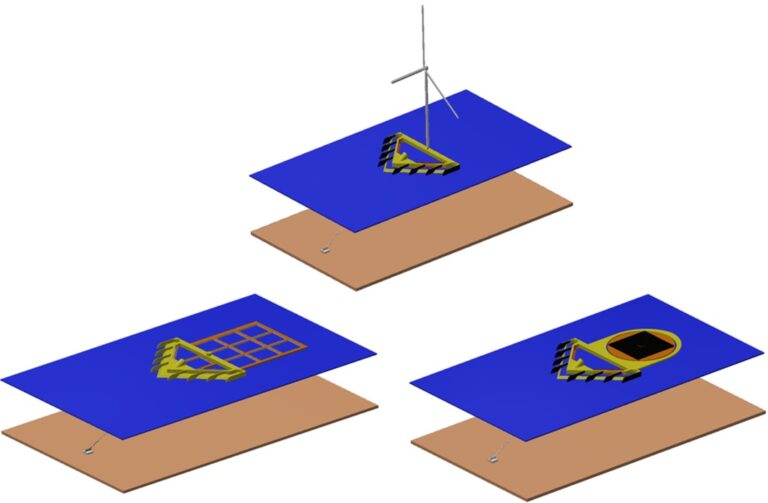Wave Energy Converter
The Scotstream wave energy converter is a floating Overtopping type device. The design is classified as a Terminator as it collects energy from the waves facing it.
The device comprises of a weathervaning floating capture structure coupled with a Hydrobox water wheel energy converter.

The wave energy collector structure weathervanes on a single point mooring system to ensure that device always rotates to face into the oncoming waves.
The waves impact the capture ramp on the front of the structure and flow upwards, over the top, into an impoundment reservoir. The ramp converts the waves horizontally directed energy flux into vertically directed potential energy by lifting the incoming water into the reservoir, where it forms a positive water head.
Once captured, the potential energy of the trapped water in the reservoir is extracted using gravity, via a Hydrobox water wheel energy converter, as the water returns to the sea .
Further information is provided in the documents below and can be provided on request.
Weathervaning Floating Capture Structure
The wave energy collector structure weathervanes on a single point mooring system to ensure that device always rotates to face into the oncoming waves.
The mooring system can be a traditional turret moored multi leg system or a submerged buoy turret system.
A single line hybrid mooring system has been used for illustration.

The power generation capacity of the converter will be directly dependent on the wave front capture length. The capture width of the current design is 170 metres. For a much larger unit with a capture width of 400 metre, the power output would be significantly increased.
The mean wave power is expressed in Kw/m of wave crest width. Energy levels of 25 kW/m and 40 kW/m have been used for typical areas.

Overtopping Capture Structure
The specification of the wave energy converter is flexible and can be adapted to suit the site wave regime.
During operation, the wave front will approach the floating structure. The wave will have potential energy in the peaks/troughs. The wave will also have kinetic energy due to the speed it is traveling.
As the wave impacts on the bow of the floating structure, it will split in two and travel down each side of the structure.
The wave will impact the sloping ramps on the sides of the structure. Due to the energy and momentum in the wave, the water will naturally move up the sloping ramp and into the impound reservoir.

The water will also move horizontally along the ramp face. A number of elevating guides will be provided on the sloping ramp to guide the water upwards into the impound reservoir.
The combination of sloping ramps and elevating guides will maximize the water transferred from the oncoming waves into the impound reservoir.
The potential and kinetic energy in the wave will be converted into potential energy in the form of the elevated stored water in the impound reservoir. This process is called overtopping.
The width of the structure and the capture ramp and impoundment reservoir can be dimensioned to suit the wave height and period. The operating draft of the structure can also be adjusted as required to suit the weather conditions.
The floating structure will have a high survivability as the main wave impact will be accommodated in the capture ramp. The structure works with the waves, rather than against them.
Hydrobox Energy Converter
The Hydrobox energy converter is basically an overshot water wheel packaged into a steel box structure. The water wheel has a high efficiency of over 80%.

The wheel diameter and length will be specified to match the height and capacity of the impoundment reservoir.
Filter screens will be provided on the water inlet to prevent large items of debris from entering the buckets.
A direct drive Generator will be mounted on the end of the wheel center shaft. The wheel is the only moving part in the Wave Energy Converter.
Floating Structure Applications
The wave energy converter structure can be used as a Multi-Purpose Platform.
A 15 MW wind turbine could be centrally mounted on the stern of the structure. On larger Structures, 2 wind turbines could be mounted to provide 30 MW of wind generation capacity.
An offshore aquaculture system could be located on the stern of the floating structure. As this area is in calm waters then existing “plastic” fish farm cages could be used. This would enable existing technology to be used and minimize costs.
A floating solar system could be located on the stern of the floating structure. As this area is in calm waters then existing “plastic” solar floats could be used. This would enable existing technology to be used and minimise costs.

The wave energy, wind energy, offshore aquaculture and floating solar systems could be combined, in any configuration onto the one Multi-Purpose Platform (MPP).
This would reduce the LCOE by sharing the Capex and Opex costs between the application, whilst at the same time providing multiple revenue streams.
Scotstream Wave Energy System Benefits
The global wave energy potential is immense. A wave energy converter “winning design” has yet to evolve.
The main consideration with all offshore renewable technologies is the Levelized Cost of Energy (LCOE). This requires the capital and operating costs to be minimized while the generating capacity and the availability of the system are maximized. This is optimized on the Scotstream design;
Capex – The main capture structure is a basic design that can be industrialized and mass produced.
Opex – The Hydrobox only has one moving part, the operations and maintenance costs should be minimal
Generation Capacity – The large capture area and the high survivability will enable the structure to generate high MW power. Coupled with an 80% conversion efficiency will result in a high generation capacity.
Availability – Personnel access will be provided at the stern of the weathervaning structure, this will enable access in all weathers for maintenance and repair.
The Scotstream wave energy converter is novel and provides a number of benefits:
Floating structure weathervanes to always face into the oncoming waves.
Optimized capture slope, coupled with variable buoyancy to maximize energy capture.
Highly efficient Hydrobox energy converter.
Only one moving part.
High Survivability.
Insensitive to wave direction, height and period.
Multi-Purpose Platform Applications
.
